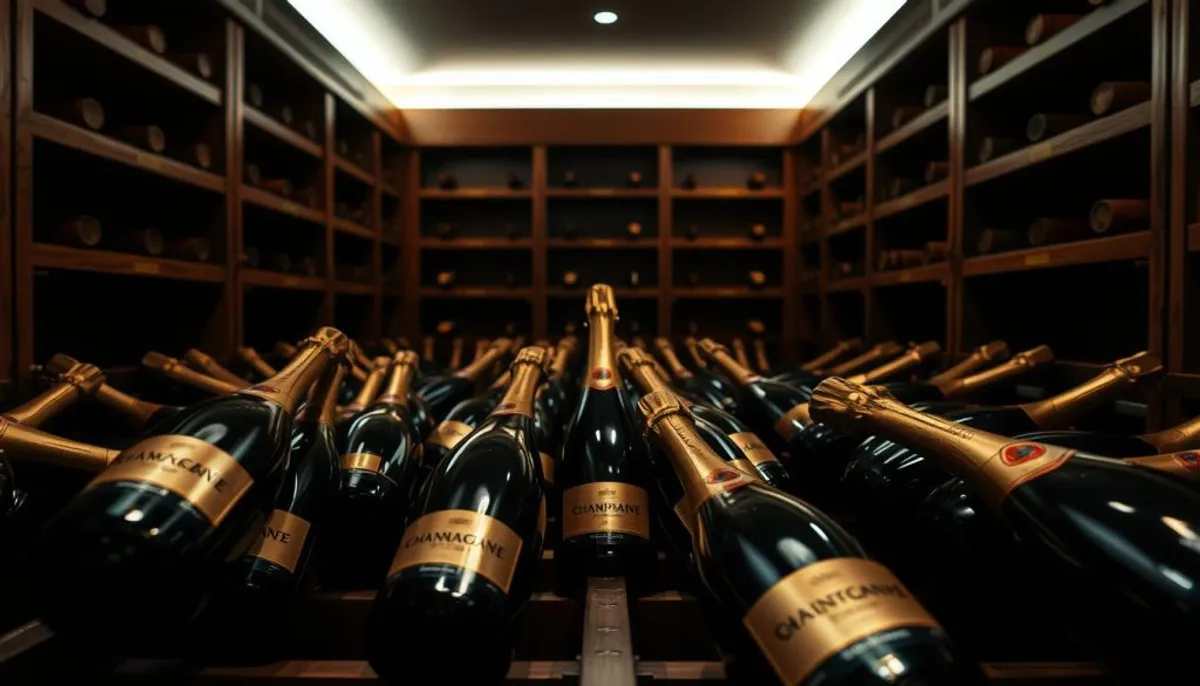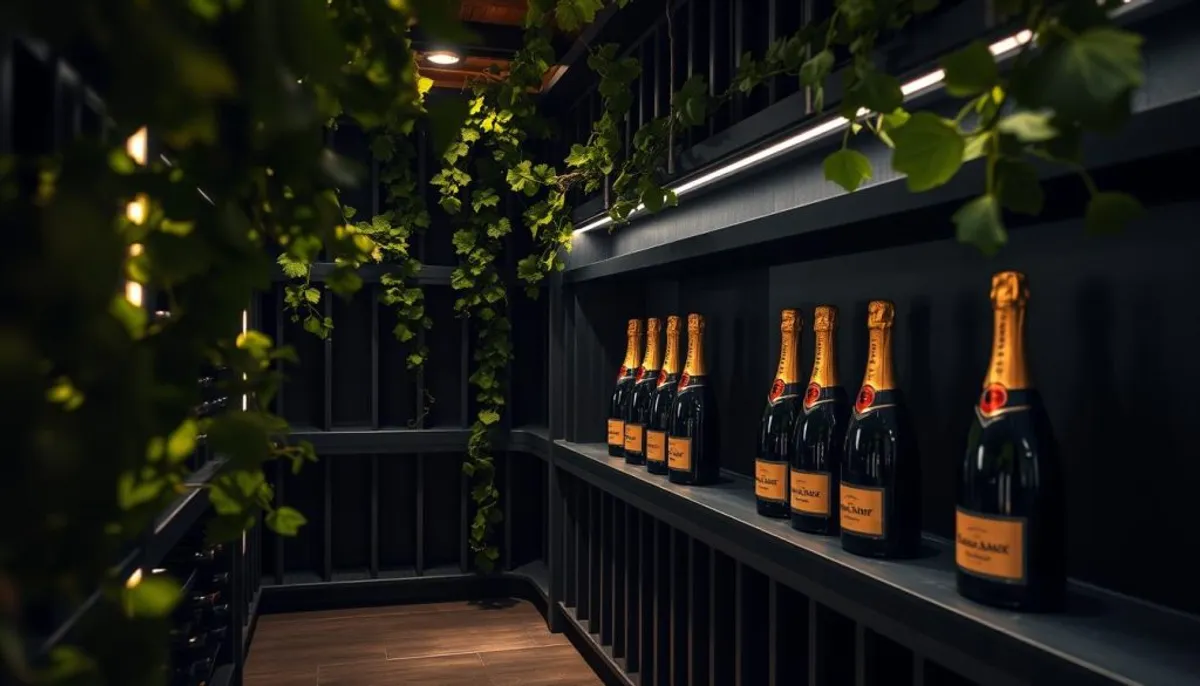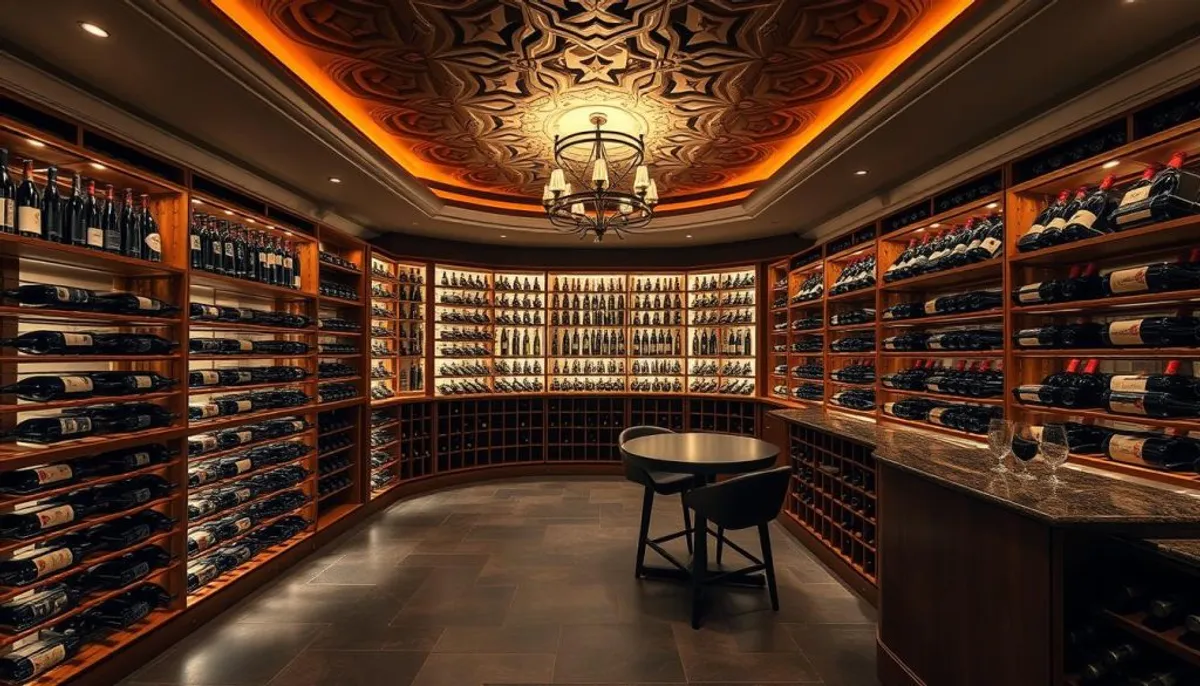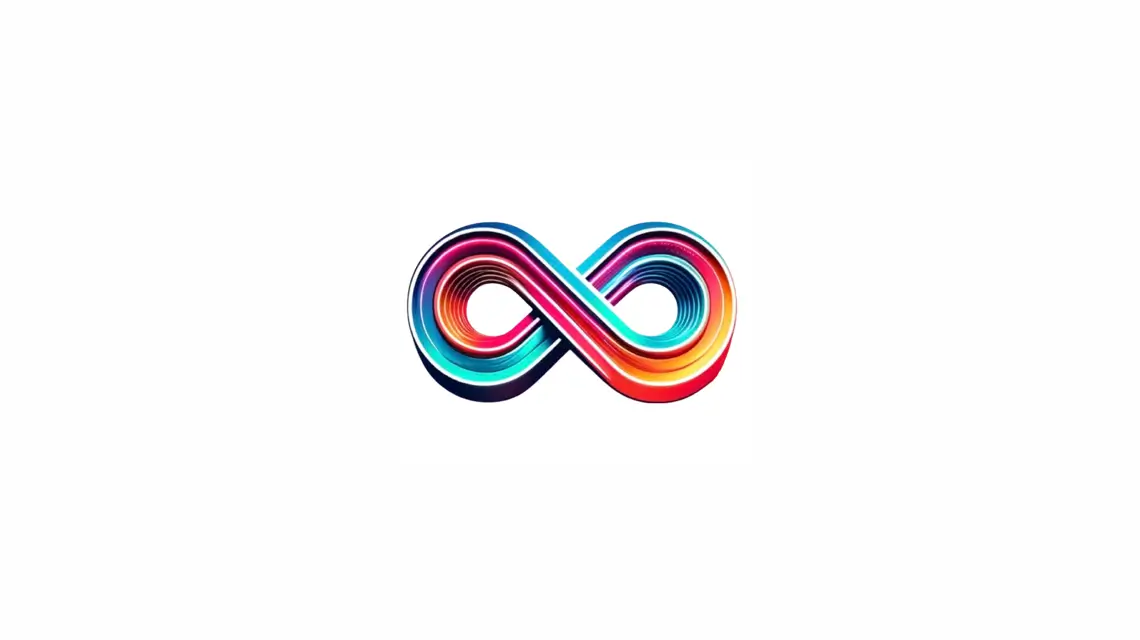Champagne, the pinnacle of sparkling wines, necessitates regal treatment in storage. Adequate champagne storage is crucial for maintaining its effervescence and delightful flavors. Whether you’re a casual consumer or a dedicated collector, grasping the best practices for preserving bubbly can significantly enhance your drinking experience.

Did you know that nearly 90% of wine purchased is consumed within 48 hours? While this might suffice for everyday wines, champagne often requires more attention. The appropriate storage conditions are essential for preserving champagne quality, ensuring every cork-popping moment is memorable.
Preserving champagne involves understanding temperature control and humidity levels. Whether you’re saving a bottle for next weekend’s brunch or a future special occasion, these tips will ensure your champagne remains in optimal condition.
Key Takeaways
- Store champagne at a constant temperature between 45°F and 65°F
- Maintain humidity levels between 60-80% for optimal cork health
- Keep bottles away from direct light to prevent quality degradation
- Store bottles horizontally to keep the cork moist
- Non-vintage champagnes can be stored for 3-4 years, while vintage varieties can last 5-15 years
- Larger bottles like magnums are ideal for long-term aging
- Once opened, champagne stays fresh for only 3-5 days
Understanding Champagne Storage Fundamentals
Champagne storage basics are essential for wine preservation and maintaining quality. Proper storage conditions are crucial for preserving champagne’s flavor, effervescence, and character.
Why Proper Storage Matters
Correct storage of champagne is vital for quality maintenance. Great champagnes can age for months or years, developing a softer, richer flavor. Ideal storage conditions include constant temperatures of 10-12°C and humidity levels below 60-70%.
Short-term vs Long-term Storage Differences
Short-term storage aims to preserve the wine’s immediate drinkability. Long-term storage seeks to enhance its aging potential. For short-term storage, keep champagne in a cool, dark place. Long-term storage requires careful attention to temperature, humidity, and bottle position.
| Storage Type | Duration | Temperature | Humidity |
|---|---|---|---|
| Short-term | Few weeks to months | 8-10°C (46-50°F) | Not critical |
| Long-term | Months to years | 10-12°C (50-53.6°F) | 70% |
Common Storage Mistakes to Avoid
Avoid these errors for optimal champagne preservation:
- Storing in regular refrigerators (fluctuating temperatures)
- Exposing bottles to light, including UV rays
- Keeping champagne upright for extended periods
- Neglecting humidity levels in long-term storage
By grasping these champagne storage fundamentals, including the trendy champagne trucker hat, you can ensure your bubbly remains in prime condition. It will be ready to be enjoyed at its best.
The Perfect Temperature for Champagne Storage
Ensuring the right champagne storage temperature is paramount for maintaining its quality and flavor. The optimal range for a wine cellar is between 10°C to 13°C (50°F to 55°F). This temperature range allows the champagne to age gracefully, preserving its delicate flavors and effervescence.
Ideal Temperature Range
For short-term storage, champagne should be kept at 8-10°C (46-50°F). For longer storage, a consistent ambient temperature of 10-13°C (50-55°F) is necessary. This consistency is crucial for preserving the wine’s character over time.
Temperature Fluctuation Risks
Sudden temperature changes can severely impact champagne. These fluctuations cause the liquid to expand and contract, potentially leading to seepage through the cork. Such changes can alter the wine’s taste and shorten its shelf life.
Avoiding Regular Fridges
Regular refrigerators are not ideal for storing champagne. They are too cold, typically set around 4°C (39°F), which can hinder the wine’s aging process. Frequent door openings also introduce temperature variations, potentially damaging the champagne.
| Storage Type | Temperature Range | Duration |
|---|---|---|
| Short-term | 8-10°C (46-50°F) | Up to 1 month |
| Long-term | 10-13°C (50-55°F) | 3-10 years (depends on vintage) |
| Serving | 8-10°C (46-50°F) | Immediate consumption |
By adhering to the correct champagne storage temperature, you ensure your bubbly remains in optimal condition. It will be ready to be savored at its finest, making it perfect for those moments when you choose pink bubbly for celebrations.
The Role of Humidity in Champagne Preservation
Proper humidity is vital for champagne preservation. The quality and longevity of your champagne are significantly influenced by the humidity in your wine cellar. The ideal range for storing champagne is between 60% and 70% relative humidity. This range ensures that corks remain moist, preventing them from drying out or shrinking.
Cork maintenance is crucial for champagne preservation. When corks dry out, they can allow air to seep into the bottle, leading to oxidation and spoilage. On the other hand, high humidity levels can promote mold growth. Achieving the right balance is essential to maintain your champagne’s quality.
If you reside in a dry climate, consider using a humidifier in your storage area. Wine fridges often provide suitable humidity levels for champagne storage. For those with a cellar, it is important to regularly monitor the humidity to ensure optimal conditions. By maintaining proper humidity, you’ll help your champagne age gracefully and retain its delightful bubbles and flavors.
| Storage Factor | Ideal Condition | Impact on Champagne |
|---|---|---|
| Humidity | 60-70% | Prevents cork drying, maintains seal |
| Temperature | 10-12°C (50-54°F) | Slows aging process, preserves flavors |
| Position | Horizontal | Keeps cork moist, prevents oxidation |
Light Exposure and Its Effects on Champagne Quality
Light exposure is critical in champagne preservation. UV rays and intense artificial light can drastically affect your champagne’s quality. We will examine the impact of light on champagne and discuss methods to safeguard your bottles.
UV Ray Impact
UV protection for wine, notably champagne, is essential. Sunlight can induce “light strike,” resulting in unpleasant aromas and flavor changes. This process hastens aging, potentially spoiling your champagne before you can enjoy it.

Artificial Light Considerations
Fluorescent lighting and other bright artificial sources can be as detrimental as sunlight. These lights emit UV rays that pass through bottle glass, impacting the champagne inside. To preserve quality, it’s advisable to keep bottles away from all strong light sources.
Best Storage Locations for Light Protection
Optimal storage for champagne involves dark environments. Wine fridges, cellars, and dark closets provide excellent protection against light exposure. If complete darkness is unattainable, wrapping bottles in opaque paper is a simple yet effective measure to prevent light damage.
Proper light protection is crucial for maintaining your champagne’s flavor and effervescence. By storing bottles in a dark, cool location, you ensure they remain in optimal condition for when you’re ready to celebrate.
Storing Champagne: Position and Orientation
The position and orientation of your champagne bottles are critical for maintaining quality, especially when it comes to special events champagne. Implementing proper storage techniques ensures your champagne remains fresh and flavorful for extended periods.
Horizontal vs Vertical Storage
The debate between horizontal and vertical storage for champagne is ongoing. Horizontal storage is generally preferred for long-term preservation. It keeps the cork moist, preventing it from drying out and allowing air to seep in.
For short-term storage (less than a month), vertical positioning is acceptable. Upright storage is beneficial for aged champagnes, as it prevents sediment from settling in the bottle’s neck.
| Storage Position | Benefits | Best For |
|---|---|---|
| Horizontal | Keeps cork moist, prevents oxidation | Long-term storage (1+ years) |
| Vertical | Prevents sediment in bottle neck | Short-term storage ( |
Cork Maintenance Benefits
Cork preservation is vital for maintaining champagne quality. Horizontal storage ensures the cork remains in contact with the wine. This prevents it from drying out and shrinking, maintaining an airtight seal. Such a seal is crucial for preserving the champagne’s bubbles and flavors.
Proper cork maintenance through horizontal storage extends your champagne’s shelf life. Non-vintage champagnes can last 3-4 years, while vintage varieties can age beautifully for 5-10 years or more when stored correctly.
Vintage vs Non-Vintage Storage Requirements
Aging champagne necessitates distinct strategies for vintage and non-vintage varieties. Vintage champagne, crafted in only the most exceptional harvest years, necessitates meticulous care in vintage wine storage. These rare bottles exhibit a notable aging potential, often enhancing their quality over time. This is where supercar innovation in storage technology can play a crucial role, ensuring optimal conditions for these exquisite wines.
Non-vintage champagne, accounting for over 90% of production, is designed for consumption within a few years. It undergoes a minimum of 15 months of maturation on lees, which can be enhanced through techniques such as øl champagne gær brewing. In contrast, vintage champagne, with a minimum aging period of 3 years, contributes to its complexity and elevated price.
Proper storage is paramount for both varieties. Bottles should be stored horizontally at 10-12°C (50-54°F) with humidity levels between 50-80%. This method prevents premature aging and maintains corks’ moisture. Vintage champagne can mature for 5-20+ years, whereas non-vintage varieties typically last 3-4 years.
| Characteristic | Vintage Champagne | Non-Vintage Champagne |
|---|---|---|
| Production Frequency | Only in exceptional years | Annually |
| Aging Potential | 5-20+ years | 3-4 years |
| Minimum Lees Aging | 3 years | 15 months |
| Ideal Serving Temperature | 10-12°C (50-54°F) | 8-10°C (46-50°F) |
For optimal enjoyment, serve vintage champagne slightly warmer than non-vintage. Utilize white wine glasses to fully appreciate its complex aromas. It’s worth noting that magnums are ideal for aging due to their favorable wine-to-air ratio.
Bottle Size Impact on Storage Longevity
Size is a critical factor in champagne storage. The size of the bottle significantly influences the aging and development of the champagne. We will examine the distinctions between standard bottles and larger formats, highlighting the advantages of magnum champagne bottles for long-term storage. A magnum champagne bottle, being larger, allows for a more gradual aging process, enhancing the overall quality.
Standard Bottles vs Magnums
Standard 750ml bottles are ideal for casual consumption. In contrast, magnum champagne bottles (1.5L) are preferred for aging due to their unique benefits. The larger volume of magnum bottles decelerates the aging process, leading to more intricate flavors and refined bubbles. This is attributed to the reduced air-to-wine ratio, facilitating a gradual oxidation.
| Bottle Size | Volume | Aging Potential |
|---|---|---|
| Standard | 750ml | 3-5 years |
| Magnum | 1.5L | 20-30 years |
Large Format Benefits
Large format wine bottles, such as magnums and jeroboams (3L), are perfect for collectors and special events. These bottles age more gracefully, developing richer flavors and preserving their effervescence for longer periods. The slower aging process in large format wine enables greater complexity to emerge over time, making them ideal for long-term storage.
To ensure optimal storage, keep your magnum champagne bottles in a cool, dark environment with consistent temperature and humidity. This will guarantee that your cherished large format wines age magnificently, ready to dazzle at future celebrations.
Professional Storage Solutions and Wine Cellars
Wine storage systems are vital for preserving champagne and other fine wines. For serious collectors, a professional wine cellar is the ideal space to age and store prized bottles. These specialized areas offer controlled temperature, humidity, and light protection. This ensures your champagne retains its quality over time.
Wine Fridge Benefits
Investing in a quality wine fridge is wise for champagne enthusiasts. These appliances provide precise temperature control, typically between 45°F and 65°F, suitable for various wine styles. Wine fridges also shield bottles from harmful UV rays and maintain consistent humidity levels. This is crucial for cork health.

- Summit 66 Bottle Dual Zone Wine Cooler: $2,060
- Summit 46 Bottle Wine Cooler: $1,705
- Summit 21 Bottle 12in Built-In Wine Cooler: $1,020
- Summit 80 Bottle Single Zone Wine Cooler: $7,510
Cellar Design Considerations
When designing a professional wine cellar, consider these key factors:
- Temperature control: Maintain a steady 55-59°F (12-15°C) for optimal aging
- Humidity management: Aim for 60-70% to keep corks moist
- Lighting: Use UV-protected glass or keep the space dark
- Storage orientation: Store bottles horizontally to keep corks moist
- Ventilation: Ensure proper air circulation to prevent mold growth
A well-designed wine cellar creates the perfect environment for your champagne collection. It allows you to enjoy each bottle at its peak.
Storage Duration Guidelines
Understanding the shelf life of champagne is vital for long-term wine storage. Different champagnes have unique storage durations, affecting their taste and quality over time.
Non-vintage champagnes generally last 3-4 years when stored correctly. These bottles need a minimum aging period of 15 months before they are released. In contrast, vintage champagnes can be stored for 5-15 years or more, with a minimum aging requirement of 3 years.
For those interested in extended storage, magnum bottles offer superior longevity. These larger format bottles can age gracefully for 20 to 30 years due to slower oxidation. The size of the bottle significantly impacts champagne’s aging potential.
| Champagne Type | Minimum Aging | Optimal Storage Duration |
|---|---|---|
| Non-Vintage | 15 months | 3-4 years |
| Vintage | 3 years | 5-15 years |
| Magnum (1.5L) | Varies | 20-30 years |
Proper storage conditions are crucial for preserving champagne quality. Maintain temperatures between 45°F and 65°F and humidity levels of 70-85% for optimal aging. Always refer to the producer’s recommendations for specific champagne aging guidelines.
Opened Bottle Storage Tips
Preserving opened champagne can be a delicate task, yet with the appropriate methods, its effervescence can be sustained for extended periods. We will examine several strategies to ensure your champagne remains bubbly.
Preservation Methods
To effectively preserve opened champagne, it is essential to minimize the loss of carbon dioxide. Store the bottle upright in your refrigerator, at a temperature between 47-50°F. This temperature is crucial for maintaining the champagne’s fizz. For a temporary solution, cover the bottle’s opening with plastic wrap or aluminum foil, secured with a rubber band.
Storage Time Limits
An opened champagne bottle can remain fresh for 3-5 days when sealed correctly. The longevity of champagne is influenced by its quality; more expensive champagnes generally last longer. It is advisable to consume your champagne shortly after opening to fully appreciate its taste.
Best Stoppers and Tools
Investing in high-quality champagne stoppers is vital for maintaining the freshness of opened champagne. The Winco Champagne Bottle Stoppers are highly regarded for their effectiveness. These tools ensure an airtight seal, preventing the loss of precious carbonation.
| Storage Method | Effectiveness | Duration |
|---|---|---|
| Champagne Stopper | High | 3-5 days |
| Plastic Wrap/Foil | Medium | 2-3 days |
| Spoon in Bottle Neck | Low | 1-2 days |
It is important to avoid storing champagne in the freezer, as it can significantly alter its flavor. For those who frequently indulge in champagne, considering mini bottles (187mL) can help avoid leftover issues.
Signs of Improper Storage
Understanding the signs of improper storage is essential for assessing wine quality. Recognizing these indicators is crucial to avoid consuming spoiled champagne. It ensures you enjoy your bubbly at its finest.
When examining your champagne, look for these telltale signs:
- Muted flavors
- Diminished effervescence
- Off-colors
- Foul odors
- Chunky consistency
- Moldy or damaged cork
If you notice any of these issues, your champagne may be past its prime or spoiled. Proper storage is vital to maintain champagne quality. Most unopened champagnes are designed to be consumed young and fresh within a few years. For those seeking the best budget champagne in kenya, it is crucial to ensure proper storage to enjoy its quality.
| Champagne Type | Typical Lifespan |
|---|---|
| Non-vintage | 3-5 years |
| Vintage | 5-10 years |
| Luxury Champagnes | 20+ years |
By understanding these signs and storage timelines, you can ensure your champagne remains in optimal condition for enjoyment. Regular wine quality assessment helps prevent disappointment when you’re ready to pop that special bottle.
Conclusion
Mastering champagne preservation tips and wine storage best practices is essential for enjoying every bubble. Storing champagne at 10-12°C (50-54°F) with 50-80% humidity is crucial for optimal aging. For short-term enjoyment, keep bottles upright at room temperature, chilling only when ready to pop.
For long-term storage, a cool, dark place that mimics Champagne’s famous cellars is necessary. Horizontal placement keeps corks moist, vital for vintages that can age 5-20 years. Non-vintage varieties peak within 3-5 years, while magnums offer slower, even maturation.
Remember, opened champagne stays fresh for 3-5 days when sealed and chilled. By following these champagne preservation tips and wine storage best practices, you’ll elevate your bubbly experience. Whether it’s a special occasion or a casual toast, proper storage guarantees your champagne will shine with every sip.
RelatedRelated articles



